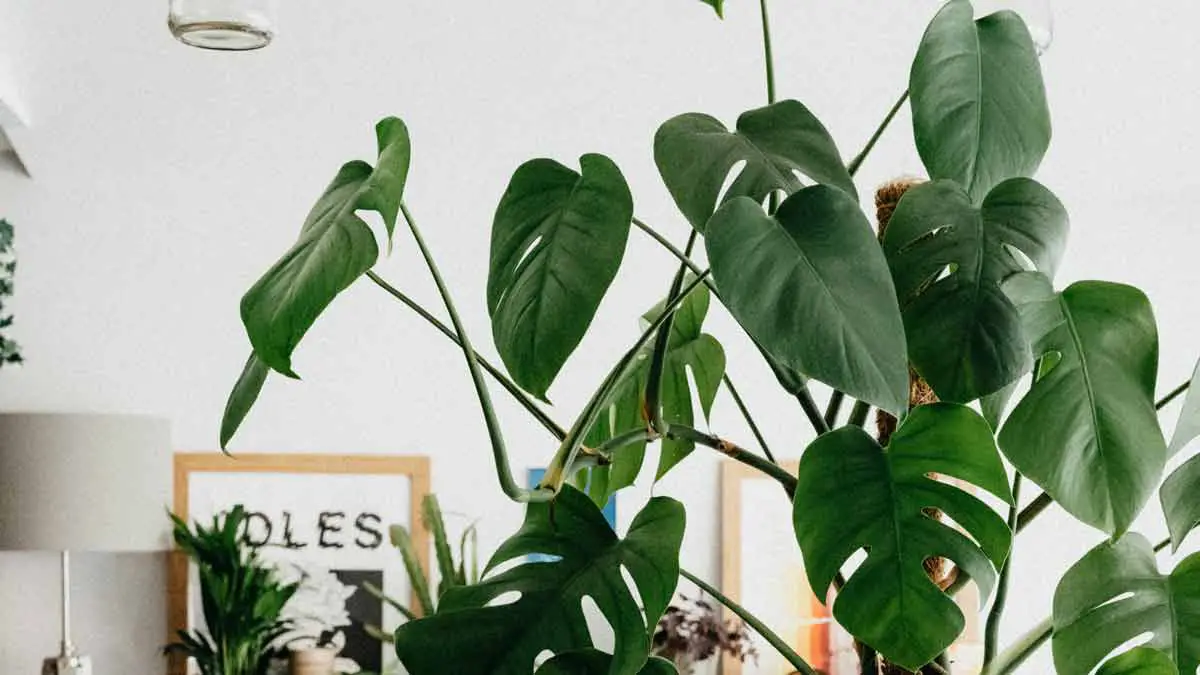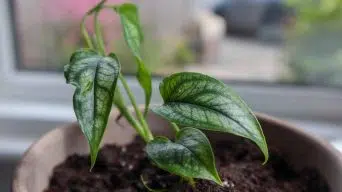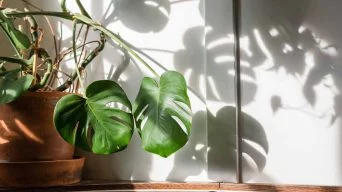To train Monstera to climb, use a support such as a moss pole or trellis. Tie vines to the support to encourage vertical growth and large leaf development. A sphagnum moss pole is most beneficial. Other options include bamboo stakes or a wall-mounted trellis. Proper support can help your Monstera grow tall and lush.
Monstera plants have taken the world of indoor gardening by storm, and it’s no surprise why – their large, split leaves exude a tropical charm that adds life to any space.
But did you know these stunning plants can also be trained to climb?
This helps them reach their full potential for an even more impressive display.
In this guide, we’ll explore the benefits of climbing Monstera plants and offer practical tips on how to train your Monstera Deliciosa or Adansonii using various support structures like moss poles and trellises.
Understanding Monstera And Its Climbing Habits
The Monstera plant, a tropical vine, can climb using aerial roots to attach itself to surrounding trees and structures in its natural environment.
Natural Habitat And Growth Habits
Monstera plants, including the popular Monstera deliciosa and Monstera adansonii, are native to the tropical rainforests of Central and South America.
These plants thrive in humid conditions in their natural habitat, with dappled sunlight filtering through the forest canopy.
As they grow, Monsteras develop large leaves with unique holes or slits – coined ‘fenestrations’ – allowing them to capture light while minimizing wind resistance efficiently.
Being climbers by nature, Monsteras use their aerial roots to attach themselves to trees or other sturdy structures as they reach for higher ground in search of sunlight.
This climbing habit supports their rapid vertical growth and helps them compete with neighboring plants.
The aerial roots serve as anchors and absorb moisture and nutrients from the surrounding environment.
By understanding these natural growth habits, plant enthusiasts can better care for Monstera plants at home by mimicking similar conditions and providing proper support structures that promote healthy upward growth.
Benefits Of Climbing For Monstera
Training your Monstera to climb provides several advantages that can contribute to this popular houseplant’s overall health and appearance.
In their natural habitat, Monstera species like deliciosa and adansonii grow as climbing plants, using their aerial roots to attach themselves to tree trunks or other structural supports.
This vertical growth habit enables the plant to reach sunlight more effectively while promoting better air circulation around its leaves.
By providing a support structure such as a moss pole or trellis for your Monstera, you can encourage it to develop larger leaves with more pronounced split patterns.
This aesthetic feature makes these plants highly sought after by enthusiasts.
As the plant climbs higher on its support, it will produce progressively bigger leaves with increased fenestration – those iconic Swiss cheese-like holes synonymous with Monsteras.
Furthermore, training your Monstera plant helps prevent excessive horizontal sprawl, which could lead to overcrowding in small indoor spaces or even damage caused by tangled vines and stems.
Supporting your Monstera’s climbing habit enhances its visual appeal. It contributes significantly towards maintaining optimal health for your beloved tropical plant.
So grab that moss pole or trellis and start training your Monstera today!
Support Structures For Training Monstera To Climb
Here we’ll see how to train your Monstera to climb easily by providing sturdy support structures such as stakes, moss poles, trellises, or hooks.
Discover the benefits of each option for your plant.
Using Stakes
One of the simplest and most accessible ways to train your Monstera to climb is by using stakes.
Stakes can be made from various materials, such as bamboo or metal, and are easy to find at any garden center or hardware store.
They work well for smaller Monstera plants or those that do not require significant support.
Insert the stake into the soil near your plant’s stem and tie it securely using soft twine.
As your Monstera grows bigger and taller, you may need to add additional stakes.
Another option is to use bamboo sticks as stakes for supporting larger stems with more robust aerial roots.
Cut a piece of bamboo stick (about 30cm) and fix it alongside an aerial root using wire mesh or twine until it reaches above where you want the leaves spread around so they will naturally wrap themselves around this structure while forming a new vine.
Using stakes supports the plant’s growing weight while encouraging vertical growth patterns rather than drooping vines that trail along the ground.
Creating A Moss Pole
A moss pole is one of the best support structures for training Monstera to climb.
This pole type is beneficial as it encourages aerial roots to attach quickly, promoting vertical growth in your plant.
You will need sphagnum or sheet moss and bamboo or coir poles to create a moss pole.
Start by wrapping the poles with dampened moss and securing them with twine or clips.
Make sure the moss is thick enough to hold moisture but not too dense that it suffocates your plant’s aerial roots.
Once you’ve created your moss pole, several methods exist for attaching Monstera plants.
You can use small stakes, garden ties, or even twist ties depending on the size of your plant and its current growth stage.
As your Monstera grows taller, re-attach any loose vines using these same attachment methods so they stay evenly spaced along the length of the pole.
Maintaining a healthy moisture level around your newly-created moss pole is critical for ensuring successful Monstera climbing behavior.
Avoid overwatering during those first few weeks after installation since both sphagnum and sheet types can retain high water levels if not allowed drying time between watering episodes.
Using a skewer or toothpick may help gauge moisture retention, especially when dealing with larger sheets that are harder to judge visually without separating individual strands from one another.
Installing A Trellis
Another option for supporting your Monstera’s climbing journey is to install a trellis.
Trellis structures are great for larger plants or if you prefer a more decorative look in your space.
Various types of trellises are available, from traditional wooden ones to modern metal designs, all of which function similarly.
To install your trellis, first, decide on the position you want it placed and secure it with screws or brackets onto the wall or ceiling.
Then, guide your Monstera towards the trellis using plant ties or clips every few inches until it can grip onto it with its aerial roots.
When utilizing a trellis system, be sure to provide enough room between each stem so that they have adequate airflow and light exposure.
Also, remember that as your Monstera grows and becomes heavier, you may need additional support for the plant itself and its support structure.
Regularly monitor and adjust ties to prevent damage to the stems or leaves caused by rubbing against other parts of their environment.
Using a trellis can be an excellent way of enhancing vertical growth while adding visual interest to any space where your Monstera resides!
Wall Or Ceiling Mounted Hooks
Wall or ceiling mounted hooks are excellent support structures for training Monstera to climb.
They can be installed onto a wall or ceiling, allowing your plant to take advantage of vertical growing space.
One benefit of these hooks is that they occupy minimal floor space, making them ideal for small apartments and homes.
To use wall or ceiling mounted hooks, you must securely attach your Monstera’s aerial roots onto the hook with twine or another type of plant tie.
As your plant grows, secure it to the hook as needed.
Using this method, you can create an attractive display out of your Monstera while keeping it healthy and happy.
For those unsure about installing hooks into their walls or ceilings, there are also options, such as adhesive-based hooks that do not require drilling.
Regardless of which option you choose, make sure your support structure is strong enough to handle your Monstera’s weight and growth habits.
Step-by-Step Guide For Training Monstera To Climb
Looking to add some vertical interest to your Monstera plant?
You can train your plant to climb and create a stunning display with a few simple steps.
Follow this step-by-step guide to get started.
Assessment Of Growth And Health
Assessing the growth and health of your Monstera is a crucial step before training it to climb.
Here are some factors to consider during the assessment process:
- Root Health: Check the roots for any signs of rot or disease. Healthy roots should be firm and white, while unhealthy roots will appear mushy and brown.
- Foliage Density: Inspect the leaves for any signs of wilting, discoloration, or damage. A healthy Monstera should have full and vibrant foliage.
- Overall Plant Vitality: Evaluate the plant’s overall appearance, including its size and shape. A healthy Monstera should have a strong stem and ample foliage.
- Age of Plant: Remember that younger plants may require more time to develop before beginning the training process.
- Environmental Factors: Consider if your Monstera is receiving adequate light, water, and nutrients in its current environment.
By carefully assessing these factors, you can ensure that your Monstera is ready to begin its climbing journey with a strong foundation for success.
Establishing A Training System
Establishing a training system is vital when teaching your Monstera plant to climb.
Assessing the plant’s growth and health before starting the process is essential.
Begin by identifying where your Monstera will grow, whether a moss pole or trellis.
Once you have decided on the ideal support structure, start pruning any new growth that doesn’t align with this direction.
Next, tie the plant loosely using soft twine or clips on its chosen support structure.
Allow enough space for new growth while regulating as required every few weeks.
Pruning is essential since overgrowing leads to tangling vines that are hard to work with later.
Regular monitoring of your Monstera will help establish an effective training system unique for each plant based on its development rate and specific requirements.
Adjustments can be made according to how well the plant responds. Still, patience is key throughout the process since visible growth results may take several months.
With these tips, you can develop long-lasting structural habits in your beloved Swiss cheese vine!
Pruning And Tying Your Plant
Pruning your Monstera plant is essential for proper growth and climbing.
Here are steps on how to do it:
- Use clean, sharp pruning shears to remove dead or yellowed leaves from your Monstera plant.
- Locate the nodes where new leaves grow from the stem and use plant ties or wire to attach the stems to your chosen support structure.
- As your Monstera climbs, continue to tie its stems to the support structure every few inches, encouraging vertical growth.
- Prune any excessively long or leggy stems that may be detracting from the overall shape of your Monstera.
- Trim back any branches blocking light from reaching other parts of the plant to encourage balanced growth.
Always prune and tie carefully and regularly monitor your Monstera for optimal health and climbing success!
Regular Monitoring And Adjustments
Training Monstera to climb is a continuous process that requires regular monitoring and adjustments.
As your plant grows, it’s crucial to ensure its continued stability by checking the support structure frequently.
Adjustments may be necessary as your plant changes direction or starts leaning away from the support system.
Neglecting these necessary steps can damage your Monstera or even complete failure of your training efforts.
It’s also important to note that different support methods require varying degrees of monitoring and adjustment.
For example, a moss pole needs frequent watering and occasional replacement when its material breaks down.
On the other hand, a trellis may need reinforcement as the weight of branches begins to strain its structure.
Understanding these differences will help you decide which method is right for you and how best to maintain it over time.
Overall, training Monstera plants requires patience and consistent care.
Keeping an eye out for signs of stress or instability through regular monitoring helps maintain a successful climbing system while ensuring a healthy growth for years to come.
Maintenance And Care Tips
Regular maintenance is key to keeping your climbing Monstera healthy and thriving.
In this section, we’ll cover important care tips such as when to add a moss pole, repotting with a moss pole, and avoiding common mistakes. Take advantage of these essential tips for ensuring your Monstera stays beautiful and strong!
When To Add A Moss Pole
As you assess the growth and health of your Monstera, you may notice that it starts to show signs of wanting to climb.
This is when adding a moss pole can be beneficial for encouraging vertical growth and larger leaves.
One indicator that your Monstera is ready for a moss pole is when it develops aerial roots, which it naturally uses to attach itself to surfaces in its natural habitat.
Another time to consider adding a moss pole is during repotting.
When your Monstera outgrows its current pot, this could be the perfect opportunity to upgrade its support system with a new moss pole.
Repotting also allows for easy attachment of the plant’s aerial roots onto the pole without causing any damage or stress on the plant.
Overall, keeping an eye on your Monstera’s growth pattern and understanding its climbing habits will help determine when to add a moss pole. By providing proper support early on, you can enjoy watching your Monstera grow into a beautiful vining houseplant in no time!
Repotting With A Moss Pole
Once your Monstera has outgrown its current pot and you have decided to repot it with a moss pole, remember a few things.
First, choose a pot at least one size larger than the current one to give the roots room to grow.
Second, prepare the moss pole by soaking it overnight in water and squeezing out any excess moisture before planting.
When adding soil, leave enough space around the base of the moss pole for your Monstera’s aerial roots to attach themselves. Water your plant after repotting and continue regular care as usual.
Over time, your Monstera will begin to climb up the moss pole using its aerial roots for support while producing bigger leaves.
It’s important not to stress or damage the aerial roots during repotting as they play a crucial role in helping your plant climb up and reach its full potential.
With patience and proper care, training your Monstera to climb using a moss pole can be an enjoyable experience for you and this beautiful tropical plant.
Common Mistakes To Avoid
When training your Monstera to climb, it’s essential to avoid these common mistakes:
- Overwatering: Too much water can cause root rot and damage the plant’s growth. Make sure to let the soil dry out partially before watering again.
- Inadequate Support: Proper support is crucial for the swiss cheese plant to climb and thrive. Neglecting this aspect can lead to stunted growth or even the death of the plant.
- Insufficient Light: Monstera plants require bright, indirect sunlight to grow well. Placing them in an area without enough light can result in poor growth and smaller leaves.
- Using Chemical Fertilizers: Chemical fertilizers can harm the Monstera plant’s delicate roots and cause chemical burns or nutrient deficiency. Instead, opt for organic fertilizers or compost.
- Cutting Off Aerial Roots: The Monstera’s aerial roots are necessary for its climbing and support system. Cutting them off can hinder their growth and negatively affect the plant’s health.
- Improper Pruning: Regular pruning helps maintain the plant’s shape and encourages new growth. However, improper pruning techniques can damage or stress the plant. Always use sterilized pruning tools and make clean cuts at a 45-degree angle.
By avoiding these common mistakes, you can train your Monstera successfully while promoting healthy growth and development for years to come!
Final Thoughts
By understanding the climbing habits of your Monstera plant and providing it with the proper support, you can train it to grow tall and lush.
Whether you use a moss pole, trellis, or other support structure, remember that regular monitoring and adjustments are crucial for success.
Your Monstera will thrive and become a beautiful addition to your indoor jungle with proper care and attention.
So try these tips and watch as your Monstera climbs its way toward new heights!







